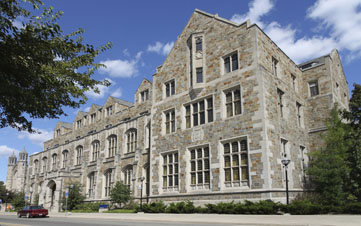10 Best Public College Values, 2014
We rank Kiplinger's top 100 public colleges and universities based on measures of academic quality and affordability -- among them, low student-faculty ratios, high graduation rates, reasonable price tags and rich financial aid, including need-based aid (grants, not loans) for students who qualify.

We rank Kiplinger's top 100 public colleges and universities based on measures of academic quality and affordability -- among them, low student-faculty ratios, high graduation rates, reasonable price tags and rich financial aid, including need-based aid (grants, not loans) for students who qualify. These ten schools are the cream of the crop of that already-elite list.
In 2014, tuition increases are slowing for in-state students at public colleges, but faltering financial aid means that the net price -- what students actually pay -- increased this year by almost 2%. But staying in-state remains an effective way to keep college costs down. The average total in-state cost this year, at $18,391, is nearly half the $31,701 price of studying out of state.
Our rankings are based on in-state costs. These top 10 schools range from small colleges to immense flagship universities, but they have one thing in common: They all deliver the most academic bang for your buck. Take a look.

1. University of North Carolina at Chapel Hill
- Undergrad enrollment: 18,503
- Student-faculty ratio: 14:1 (top-100 median, 17:1)
- Graduation rate: 4-yr., 77%; 6-yr., 90% (natl. avg., 4-yr., 32%; 6-yr., 53%)
- Annual total in-state cost: $19,676 (natl. avg., $18,391 for tuition, fees, room and board)
- Annual total out-of-state cost: $41,458 (natl. avg., $31.701)
- Avg. debt at graduation: $16,983 (natl. avg., $29,400 for 2012)
The Tar Heels are number one for the 13th time – as many times as Kiplinger’s has ranked public colleges.
UNC is the only school on our list to meet 100% of financial need, slashing its $19,676 total cost to $6,454, on average, for students who qualify. This need-based aid is awarded as grants, not loans, to nearly 40% of UNC freshmen this year after need-based aid is applied. A 28% admission rate (the lower, the better) means that only the most competitive applicants gain entry. And most students graduate on time, with 77% completing their degrees in four years and 90% in six years.

2. University of Virginia
- Undergrad enrollment: 15,822
- Student-faculty ratio: 16:1
- Graduation rate: 4-yr., 87%; 6-yr., 93%
- Annual in-state cost: $23,415
- Annual out-of-state cost: $50,801
- Avg. debt at graduation: $21,591
When it comes to academic quality and affordability, UVA is a strong contender. Its $23,415 sticker price comes in above the national average of $18,391, but UVA charges $5,070 after need-based aid, the lowest cost in our top ten and below the average of $12,620. Among incoming freshmen, 37% score above 700 on the verbal SAT test and 48% score above 700 on the math exam. And if you don’t want to shell out for an extra year of tuition, this school is for you: It has the highest four and six-year graduation rates (at 87% and 93%) in our top 100. Graduates who borrowed head into the real world with an average debt of just over $21,000—relatively modest compared with the national average of $29,400.

3. University of Florida
- Undergrad enrollment: 32,776
- Student-faculty ratio: 21:1
- Graduation rate: 4-yr., 64%; 6-yr., 85%
- Annual in-state cost: $16,863
- Annual out-of-state cost: $39,140
- Avg. debt at graduation: $19,636
At $16,863, the University of Florida has the lowest total in-state cost of our top ten. The cost after need-based aid is applied is $10,679, and students graduate with less than $20,000 in debt.
With more than 30,000 undergraduates, UF is the largest school in our top ten. Its 2,000-acre campus, with 900 buildings, is a hub for medical and scientific research, including the world’s largest citrus research center. Florida’s Bright Futures Scholarship program helps in-state students with good academic records cover tuition and fees.

4. The College of William and Mary
- Undergrad enrollment: 6,171
- Student-faculty ratio: 12:1
- Graduation rate: 4-yr., 83%; 6-yr., 90%
- Annual in-state cost: $26,285
- Annual out-of-state cost: $49,262
- Avg. debt at graduation: $24,344
The nation’s second-oldest college continues its tradition of excellent academics. Just 32% of applicants earn admission to this “public Ivy.” The 12-to-one student-faculty ratio is the lowest in our top ten.
William and Mary’s $26,285 total in-state cost drops to $13,436 after need-based aid. That’s a significant reduction from the sticker price but still the highest net cost in our top ten.

5. University of California, Los Angeles
- Undergrad enrollment: 27,941
- Student-faculty ratio: 16:1
- Graduation rate: 4-yr., 71%; 6-yr., 92%
- Annual in-state cost: $28,852
- Annual out-of-state cost: $51,730
- Avg. debt at graduation: $20,409
Located in the Westwood neighborhood of Los Angeles, UCLA offers more than 800 clubs and student organizations, plus 125 majors. Its location in a major city gives students the internship and work opportunities that a small college town can’t.
Applicants to UCLA face steep competition: The admission rate is a competitive 22%, second-lowest on our list. Need-based financial aid brings UCLA’s nearly $30,000 in-state price tag to $11,483; students who borrow graduate with just over $20,000 in debt, on average. That’s almost $10,000 less than the national average.

6. University of Michigan
- Undergrad enrollment: 27,979
- Student-faculty ratio: 16:1
- Graduation rate: 4-yr., 76%; 6-yr., 91%
- Annual in-state cost: $24,186
- Annual out-of-state cost: $51,436
- Avg. debt at graduation: $27,815
UM has ascended our rankings over the past three years, thanks to limited cost increases and improving academics.
Michigan’s tuition is relatively high ($12,948 for in-state students, and $24,186 in total costs), but the 2014 tuition increase for residents was the smallest since 1985. The total cost after need-based aid has actually decreased since 2011, to $10,930. This year, the four-year graduation rate jumped three percentage points, to 76%.

7. University of Maryland, College Park
- Undergrad enrollment: 26,487
- Student-faculty ratio: 18:1
- Graduation rate: 4-yr., 63%; 6-yr., 82%
- Annual in-state cost: $19,972
- Annual out-of-state cost: $39,158
- Avg. debt at graduation: $25,276
Located along the Baltimore-Washington, D.C., corridor, Maryland’s flagship university lands at number seven this year, its sixth consecutive year in the top ten. Its total cost falls below $20,000, and the net cost becomes $13,490, on average, after need-based aid is applied. Maryland’s low cost helps secure its spot in the top ten, but its academics are nothing to shrug off: The university admits fewer than half of its applicants, and its 18-to-one student-faculty ratio gives students plenty of face time with professors.

8. University of Wisconsin-Madison
- Undergrad enrollment: 30,863
- Student-faculty ratio: 17:1
- Graduation rate: 4-yr., 54%; 6-yr., 83%
- Annual in-state cost: $19,957
- Annual out-of-state cost: $36,207
- Avg. debt at graduation: $24,700
Get this: When it comes to what students actually pay, Madison costs less this year than last. The average cost after need-based aid for residents dropped to $12,636 from $13,430.
The city of Madison, with its masses of young people, political jobs at the state capitol and myriad tech start-ups, has become a midwestern magnet for Millennials. Maybe that, plus solid academics, helps explain why 95% of students stick around after freshman year.

9. University of California, Berkeley
- Undergrad enrollment: 25,774
- Student-faculty ratio: 17:1
- Graduation rate: 4-yr., 71%; 6-yr., 91%
- Annual in-state cost: $29,280
- Annual out-of-state cost: $52,158
- Avg. debt at graduation: $17,964
Talk about competitive. Just 18% of applicants gain entry to Berkeley, the lowest admission rate on our list. Among the incoming freshmen, 36% scored more than 700 on the verbal SATs; 56% beat that score in the math portion.
Berkeley’s $29,280 is the highest in-state total cost in our top ten, but its average need-based aid brings it to a much more doable $12,651. Students who borrow graduate with less than $18,000 in average debt.

10. University of Georgia
- Undergrad enrollment: 26,259
- Student-faculty ratio: 18:1
- Graduation rate: 4-yr., 55%; 6-yr., 83%
- Annual in-state cost: $20,424
- Annual out-of-state cost: $38,634
- Avg. debt at graduation: $19,621
- Financial aid is generous, cutting Georgia’s $20,424 total cost to less than $12,000 for in-state students. Students graduate with less than $20,000 in debt. Residents with stellar high school records can qualify for the Hope Scholarship, which covers a portion of tuition.
Georgia jumped five places in our rankings this year, thanks to improved test scores and a more competitive admission rate. It has one of the highest yields in our top ten: Nearly half of students who earn acceptance letters choose to enroll, and 94% stick around after the first year.

Get Kiplinger Today newsletter — free
Profit and prosper with the best of Kiplinger's advice on investing, taxes, retirement, personal finance and much more. Delivered daily. Enter your email in the box and click Sign Me Up.
Susannah Snider worked as a research-reporter and staff writer at Kiplinger Personal Finance Magazine. She went on to serve as managing editor for money at U.S. News, overseeing articles and content covering real estate, personal finance and careers. She is a certified financial planner professional and earned her CFP marks in 2019.
-
 Stock Market Today: Stocks Rise Despite Stagflation Risk
Stock Market Today: Stocks Rise Despite Stagflation RiskThe business of business continues apace on continuing hope for reduced trade-related uncertainty.
-
 Do You Want An Extra $50,000 In Your 401(k)? Delay Retiring
Do You Want An Extra $50,000 In Your 401(k)? Delay RetiringDon’t think putting off retiring for six months to a year will have a meaningful impact? Think again. See how much it can help.
-
 What to Do With Your Tax Refund: 6 Ways to Bring Growth
What to Do With Your Tax Refund: 6 Ways to Bring GrowthUse your 2024 tax refund to boost short-term or long-term financial goals by putting it in one of these six places.
-
 What Does Medicare Not Cover? Eight Things You Should Know
What Does Medicare Not Cover? Eight Things You Should KnowHealthy Living on a Budget Medicare Part A and Part B leave gaps in your healthcare coverage. But Medicare Advantage has problems, too.
-
 15 Reasons You'll Regret an RV in Retirement
15 Reasons You'll Regret an RV in RetirementMaking Your Money Last Here's why you might regret an RV in retirement. RV-savvy retirees talk about the downsides of spending retirement in a motorhome, travel trailer, fifth wheel or other recreational vehicle.
-
 The Six Best Places to Retire in New England
The Six Best Places to Retire in New Englandplaces to live Thinking about a move to New England for retirement? Here are the best places to land for quality of life, affordability and other criteria.
-
 The 10 Cheapest Countries to Visit
The 10 Cheapest Countries to VisitWe find the 10 cheapest countries to visit around the world. Forget inflation woes, and set your sights on your next vacation.
-
 15 Ways to Prepare Your Home for Winter
15 Ways to Prepare Your Home for Winterhome There are many ways to prepare your home for winter, which will help keep you safe and warm and save on housing and utility costs.
-
 Six Steps to Get Lower Car Insurance Rates
Six Steps to Get Lower Car Insurance Ratesinsurance Shopping around for auto insurance may not be your idea of fun, but comparing prices for a new policy every few years — or even more often — can pay off big.
-
 How to Increase Credit Scores — Fast
How to Increase Credit Scores — FastHow to increase credit scores quickly, starting with paying down your credit card debt.
